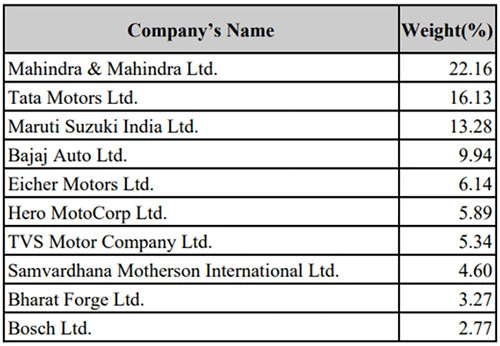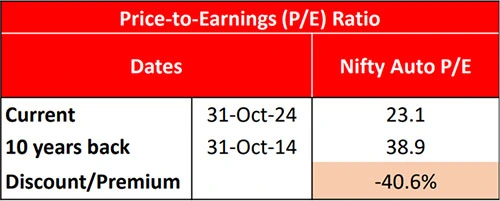Publish Date:
It appears that Nippon India Mutual Fund, the country's fourth largest fund house by AUM, is consciously building its product basket by launching passively managed Index Funds. The recent addition is the Nippon India Nifty Auto Index Fund.
The Auto industry after witnessing a setback during the COVID-19 pandemic, is now seeing a post-pandemic recovery abetted by pent-up demand, a shift towards EVs and SUVs, and a preference for safer vehicles and premiumisation. The government's Production Linked Incentive (PLI) scheme has also been supportive.
Table 1: Automobile Production Trends (in Numbers)
 (Source: SIAM)
(Source: SIAM)
Not just the vehicle manufacturers have benefited but even the auto component and spare manufacturers.
Sales of 2-wheelers, 4-wheelers, and auto component manufacturers have gone up since the lows of the COVID-19 pandemic.
Table 2: Automobile Domestic Sales Trends (in Numbers)
 (Source: SIAM)
(Source: SIAM)
India also holds a strong position in the international heavy vehicles arena as it is the largest tractor manufacturer, second-largest bus manufacturer, and third-largest heavy truck manufacturer in the world.
Paying heed to encouraging market dynamics and recognising India's favourable demographics -- with a younger working population and growing aspirations -- several companies in the auto industry are committing additional investments and expanding their capacities. At present, 100% Foreign Direct Investment (FDI) is allowed under the automatic route in India's automobile sector. Between April 2000 and March 2024, cumulative equity FDI inflow received by the auto industry was about USD 36.3 billion, while the inflows for FY24 stood at USD 1.5 billion (5% of total inflows).
Today India is the third largest automobile market (valued at Rs 6.15 trillion), riding in top gear, employing millions of people directly or indirectly, and aims to grow in years to come.
In the last few years, the Nifty Auto Index has been one of the decent-performing indices. Last year, i.e. the calendar year 2023, the Nifty Auto Index exhibited an exceptional performance and outdid the Nifty 50 - TRI.
Table 3: Performance of Nifty Auto- TRI v/s Nifty 50 - TRI
|
Calendar Year |
Nifty Auto - TRI (%) |
Nifty 50 - TRI (%) |
|
2019 |
-8.86 |
13.02 |
|
2020 |
13.58 |
16.01 |
|
2021 |
19.37 |
25.33 |
|
2022 |
14.90 |
4.11 |
|
2023 |
48.63 |
20.91 |
|
2024* |
29.63 |
12.79 |
*YTD as of November 12, 2024
TRI - Total Return Index considered.
(Source: ACE MF, Data collated by PersonalFN Research)
Even in the calendar year 2024, the Nifty Auto - TRI has clocked over 29% absolute returns so far (as of November 12, 2024).
Against the backdrop of the above, Nippon India Mutual Fund has launched the Nippon India Nifty Auto Index Fund. It is an open-ended scheme replicating/tracking the Nifty Auto Index. Thus, the returns would commensurate with that of the underlying benchmark index., i.e. the Nifty Auto TRI, subject to tracking error.
During the NFO period, the Scheme is open for subscription from November 14, 2024, to November 28, 2024. Thereafter the scheme re-opens for subscription on December 10, 2024.
Under normal circumstances, the Scheme would allocate 95% to 100% of its total assets in securities constituting the Nifty Auto Index.
The Scheme may also take up to 20% exposure to equity derivatives -- the index itself or its constituent stocks -- for hedging (to reduce the risk of the portfolio) and non-hedging purposes. This would be done when equity shares are unavailable, insufficient or for rebalancing in case of corporate actions for a temporary period. Such exposure to derivatives will be rebalanced within 7 days.
The Scheme may engage in Securities Lending not exceeding 15% of the net assets of the scheme and shall not lend more than 5% of its net assets to a single counterparty (here counterparty means an intermediary/broker through whom we deal in securities) or such other limits as may be permitted by SEBI.
Up to 5% of the fund's total assets would be held in cash & cash equivalents, money market instruments, and/or Schemes which invest predominantly in the money market securities or Liquid Schemes. The Scheme may also invest in unrated debt & money market instruments.
The Scheme will not invest in securitized debt, ADR, GDR, Foreign Securities, REITs and InvITs, Fund of Fund (FoF) Scheme, Credit Default Swaps (CDS), Debt Instruments with special features (AT1 and AT2 Bonds), debt Instruments with Structure Obligations (Sos) or Credit Enhancements (CEs), nor will it engage in short selling and Repo in corporate debt.
The Fund Manager would monitor the tracking error of the Scheme on an ongoing basis and would seek to minimize the tracking error.
Tracking error or tracking difference may arise due to the following reasons:
-
Delay in purchase or non-availability of underlying securities forming part of the index.
-
Delay in liquidation of securities which have been removed by the Index.
-
Fees and expenses of the Scheme.
-
Cash balance held by the Scheme due to interest received during subscriptions, redemption, etc.
-
Halt in trading on the stock exchange due to circuit filter rules.
-
In the case of corporate actions.
-
If the Scheme has to invest in the securities in whole numbers and has to round off the quantity of securities.
-
In the case of dividend payout
-
Changes in the constituents of the underlying Index. Whenever there are any changes, the Scheme has to reallocate its investment as per the revised Index but market conditions may not offer an opportunity to rebalance its portfolio to match the Index and such delay may affect the NAV of the Scheme.
Under normal circumstances, the AMC shall endeavour that the tracking error of the Scheme shall not exceed 2% per annum.
However, in case of unavoidable circumstances like force majeure, which are beyond the control of the AMCs, the tracking error may exceed 2% and the same shall be brought to the notice of Trustees with corrective actions taken by the AMC, if any.
There is no assurance or guarantee that the Scheme will achieve any particular level of tracking error relative to the performance of the underlying Index.
What is the Investment Objective?
The investment objective of the scheme is to provide investment returns that commensurate to the total returns of the securities as represented by the Nifty Auto Index before expenses, subject to tracking errors.
However, there is no assurance that the investment objective of the Scheme will be achieved.
What Is the Investment Strategy?
The Nippon India Nifty Auto Index Fund will follow a passive investment approach designed to track the performance of the Nifty Auto TRI.
The Scheme seeks to achieve this goal by investing in securities constituting the Nifty Auto Index in the same proportion as in the Index.
The AMC does not make any judgments about the investment merit of the Nifty Auto Index nor will it attempt to apply any economic, financial or market analysis. The investments would be done by investing in almost all the stocks comprising the Nifty Auto Index in approximately the same weightage that they represent in the Nifty Auto Index. At least 95% of the total assets of the Scheme will be in the securities comprising the underlying index.
The Scheme may also invest (up to 5% of the total assets) in money market instruments to meet the liquidity and expense requirements.
The Scheme will benchmark its performance against the Nifty Auto TRI.
About the Nifty Auto Index
The Nifty Auto Index (launched on July 12, 2011, with a base date of January 1, 2004) is designed to reflect the behaviour and performance of the Indian automobile sector in the financial market.
The Nifty Auto Index comprises 15 tradable, exchange-listed companies. The index represents auto-related sectors like automobiles 4 wheelers, automobiles 2 & 3 wheelers, auto ancillaries and tyres.
The Nifty Auto Index is computed using the free float market capitalisation method with a base date of January 1, 2004, indexed to a base value of 1,000. The level of the index reflects the total free float market value of all the stocks in the index relative to a particular base market capitalisation value and this index is rebalanced semi-annually (in March and September).
At present, the top constituents of this index are as under:
Table 4: Top 10 Constituents of the Nifty Auto Index
 (Source: NSE Indexogram Factsheet as of October 31, 2024)
(Source: NSE Indexogram Factsheet as of October 31, 2024)
In the last one year, the Nifty Auto Index has clocked an appealing price return of 48.6% and a total return (which includes dividends) of 49.7% on an absolute basis (as of November 12, 2024).
In the last 5 years, the Nifty Auto Index has clocked a price return of 23.6% CAGR and a total return (which includes dividends) of 24.9% (as of November 12, 2024).
Who Will Manage Nippon India Nifty Auto Index Fund?
Mr Himanshu Mange, who has over 5 years of experience will be managing the Scheme. He has been with Nippon India Mutual Fund since February 2022. From December 2023, he was appointed as Fund Manager & Dealer - ETF, at Nippon Asset Management Company. Before that, his role was Dealer - ETF.
Before joining Nippon Asset Management, Himanshu was with TATA AIA Life Insurance Co. Ltd. as an Assistant Manager (Investment Operations - Finance & Accounts).
Himanshu is a Chartered Accountant by qualification. At Nippon Indian Mutual Fund, he manages various other index funds and Exchange Traded Funds (ETFs).
How much is the Minimum Investment in Nippon India Nifty Auto Index Fund?
During the NFO period and ongoing/continuous basis, the minimum investment in the Scheme is Rs 1,000/- and in multiples of Re. 1/- thereafter.
Investors can also avail of the Systematic Investment Plan (SIP) mode to make investments. In case the investor has not specified the frequency then by default the frequency will be treated as monthly.
[Read: Why Discontinuing/Pausing Your SIPs Isn't the Best Move in a Volatile Market]
Both, the Direct Plan and Regular Plan for available for investments plus the options available are Growth and Income Distribution cum Capital Withdrawal (IDCW).
Who Should Consider Nippon India Nifty Auto Index Fund?
Investors looking to bet on India's auto & auto ancillary and tyre manufacturers with a low-cost option, have a very high-risk appetite, and a longer investment horizon of 7-8 years or so, can consider the Nippon India Nifty Auto Index Fund.
That said, the fortune of the Scheme will be closely aligned with that of the Nifty Auto Index. In other words, the returns would commensurate with that of this underlying index and there would be concentration risk.
Table 5: Nifty Auto Index Valuations
 (Source: Nippon India Mutual Fund Investor Presentation)
(Source: Nippon India Mutual Fund Investor Presentation)
Currently, the trail Price-to-Equity (P/E) ratio of the Nifty Auto Index is at 23x -- noticeably lower than 10 years ago and the long-term average. The Price-to-Book Value (P/BV) ratio of this index is nearly 5x, slightly lower than the long-term average.
However, a fact is that the Indian is that Indian equities, by and large, are commanding a premium compared to global peers. If the market corrects, it may even weigh on the Nifty Auto Index as well. As mentioned before, there is a concentration risk involved. Given the market risk involved due to geopolitical and economic uncertainty, it is not a very conducive environment to take sector-specific concentration risk.
To learn more about the Nippon India Auto Index Fund, read the Scheme Information Document and Key Information Memorandum.
Happy Investing!